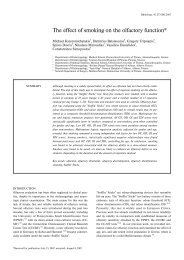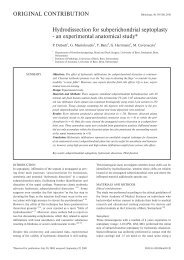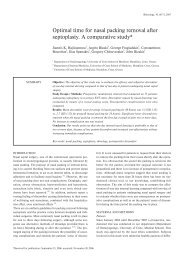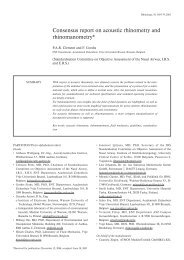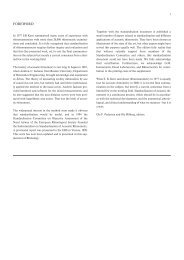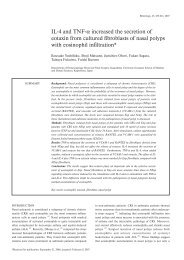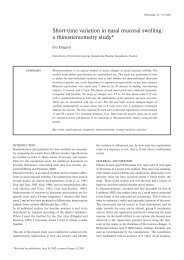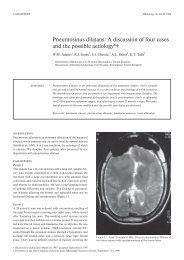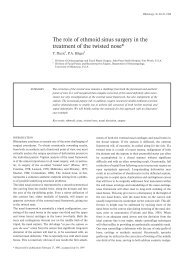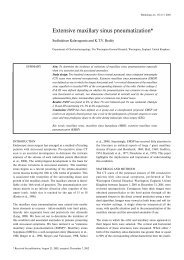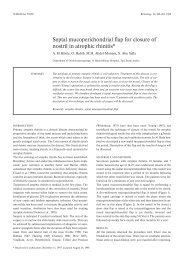Free Download - Rhinology Internation Journal
Free Download - Rhinology Internation Journal
Free Download - Rhinology Internation Journal
You also want an ePaper? Increase the reach of your titles
YUMPU automatically turns print PDFs into web optimized ePapers that Google loves.
<strong>Rhinology</strong>, 42, 81-84, 2004<br />
Partial laser turbinectomy: two year outcomes in<br />
patients with allergic and non-allergic rhinitis*<br />
A.S. Sandhu, R.H. Temple, M.S. Timms<br />
Department of Otorhinolaryngology, Blackburn Royal Infirmary, Blackburn, Lancashire BB2 3LR, England<br />
SUMMARY<br />
Objective: The aim was to compare two year outcomes of partial laser turbinectomy in<br />
patients with allergic and non-allergic rhinitis with respect to nasal obstruction symptom<br />
scores and nasal peak inspiratory flow rates (nPIFR). This has not been reported previously.<br />
Method: Fifty-four patients underwent partial laser turbinectomy (28 with allergic rhinitis, 26<br />
with non-allergic rhinitis). NPIFR was measured preoperatively, at 3 months and two years<br />
postoperatively. A symptom score questionnaire was also completed.<br />
Results: Both allergic and non-allergic patients showed a significant improvement in symptom<br />
scores and nPIFR at three months (n=54). The improvement in allergic patients was greater.<br />
In the 31 patients seen at two years, there was still a significant improvement in median symptom<br />
scores but no such improvement in median nPIFR. In allergic patients (n=18) at two<br />
years, there was no significant improvement in symptom and nPIFR scores. Non-allergic<br />
patients (n=13), however, did show sustained significant improvement in these scores<br />
(p18 years) with a history, examination and<br />
specific IgE antibody (RAST, radioallergosorbent test) results<br />
consistent with a diagnosis of allergic or non-allergic rhinitis<br />
were included. Criteria from the history included symptoms of<br />
nasal obstruction, rhinorrhea, ocular pruritis, postnasal drip,<br />
sneezing and anosmia. Examination criteria included nasal<br />
mucosal oedema, clear rhinorrhea and oedematous enlarged<br />
turbinates. Patients with other nasal pathology, including nasal<br />
polyps, septal perforations and gross septal deviations were<br />
*Received for publication: October 31, 2003; accepted: February 12, 2004
82 Sandhu et al.<br />
excluded. Any patients who had undergone previous nasal<br />
surgery were also excluded. Patients with specific IgE scores<br />
greater than 40 IU/l and the above symptoms were diagnosed<br />
as allergic rhinitis. Those with specific IgE values less than 40<br />
IU/l were diagnosed as non-allergic rhinitis. Specific allergens<br />
used were house dust mite, cat and dog epithelia, molds and<br />
grasses. All patients in the study had failed to respond to medical<br />
treatment and had hypertrophied inferior turbinates.<br />
External temperature, humidity variation, and exercise, can all<br />
affect the degree of vascularity of the nasal mucosa. To standardise<br />
conditions prior to measurement nPIFR, the patient<br />
sat on the ward for 30 minutes. During this time the patients<br />
were asked about their nasal symptoms in a pre-operative<br />
assessment questionnaire and were asked to grade their nasal<br />
obstruction on a visual analogue scale (from 1-10) (see appendix).<br />
Measurements of nPIFR were then made using the<br />
Incheck nasal peak inspiratory flow rate meter (Clement<br />
Clarke <strong>Internation</strong>al Ltd).<br />
They were taught the correct method of using the meter and<br />
an average of 3 readings was recorded. Careful observation of<br />
technique was made, checking especially for alar collapse. All<br />
patients underwent bilateral laser partial inferior turbinectomy.<br />
The operations were performed under local or general anaesthetic,<br />
by two of the authors.<br />
A volume of 2.2mls of 2% xylocaine with 1:80,000 adrenaline<br />
was injected into muco-cutaneous junction of the inferior<br />
turbinate. A silastic splint was inserted into each nasal cavity to<br />
protect the nasal septum during the procedure. The carbon<br />
dioxide (CO 2 ) laser in super-pulse mode set at 10 watts continuous<br />
power was used to reduce the anterior 30% of the inferior<br />
turbinate. The laser beam was mildly defocused to spread the<br />
area of laser contact. No nasal packs were used routinely after<br />
the operation and the patients were all discharged the same<br />
day from hospital.<br />
Patients were invited to return to the out-patient department<br />
after 3 months and 2 years for follow-up examination and evaluation<br />
of their nasal airflow.<br />
RESULTS<br />
All 54 patients (19 female and 35 male) underwent laser partial<br />
inferior turbinectomy. The median age was 33 years (range, 18-<br />
70 years). They all complained of nasal obstruction as their<br />
main symptom. Twenty-six patients (48%) were classified with<br />
allergic rhinitis, with specific IgE results greater than 40 IU/l<br />
(range 45-2119 IU/l). The remaining 28 patients (52%) were<br />
diagnosed with non-allergic rhinitis, (specific IgE range: 1-35<br />
IU/l).<br />
As the study group did not conform to a standard distribution<br />
of symptom scores and airflow measurements, median values<br />
were used.<br />
At three months, the group (n=54) showed a significant<br />
improvement in both median symptom score (p
Laser turbinectomy in rhinitis 83<br />
were 5 (range, 3-8) and 8 (range 5-10) respectively. This is a<br />
median percentage increase of 40.0% (range 0-200%) in symptom<br />
score.<br />
Pre-operatively, the median nPIFR was 80 l/min (range, 30-156<br />
l/min), and post-operatively was 115 l/min (range,60-230<br />
l/min).This represents a median increase in nPIFR of 38%<br />
(range 3-284%).<br />
The improvement was also significant when the group was<br />
divided into allergic (n=26) and non-allergic individuals (n=28)<br />
(Table 2).There was no difference between the allergic and<br />
non-allergic groups in the pre- and post-operative symptom<br />
median scores and ranges. The allergic group experienced a<br />
greater percentage increase in nPIFR (42.5% compared with<br />
37.5% in the non-allergic group).<br />
When looking at post-operative morbidity there were no<br />
episodes of haemorrhage that required nasal packing or an<br />
overnight hospital stay and there were no episodes of secondary<br />
haemorrhage. At 3 months there were no cases of<br />
adhesions between the nasal septum and the lateral nasal wall<br />
and no patients were listed for revision surgery.<br />
Thirty-one patients (57.4%) attended for follow-up at 2 years<br />
(Tables 1 and 3). Of these 18 were in the allergic group and 13<br />
in non-allergic group. In this group (n=31) there was still a significant<br />
improvement in symptom scores compared to preoperatively,<br />
but no significant improvement nPIFR The median<br />
symptom score was 7 (range 2-10). The median percentage<br />
increase was 28.6% (range -33 to 200). The median nPIFR was<br />
Table 3. The statistical significance of symptom scores and nasal peak<br />
inspiratory flow rates (nPIFR) of allergic and non-allergic patients at<br />
two years postoperatively using paired student's t-test. p0.05<br />
nPIFR<br />
Preoperative 95.00 31.10<br />
Postoperative 93.00 37.90<br />
t 1.75<br />
p<br />
p>0.05<br />
Non-Allergic Patients (n=13)<br />
Subjective Scores<br />
Preoperative 5.00 1.61<br />
Postoperative 8.00 1.98<br />
t -4.75<br />
p<br />
p
84 Sandhu et al.<br />
However, it would seem that non-allergic patients derive more<br />
sustained improvement in terms of symptom scores and<br />
nPIFR in the medium term compared to allergic patients,<br />
although 83% (15/18) of allergics would still recommend the<br />
operation.<br />
In our ever increasing world of evidence based medicine, we<br />
have found the results from this study helpful in recommending<br />
this treatment to patients and we are able to guide patient<br />
expectation as to the likely increase in their nasal airflow after<br />
a laser partial inferior turbinectomy depending on their allergic<br />
status.<br />
ACKNOWLEDGEMENTS<br />
We wish to acknowledge Clement Clarke <strong>Internation</strong>al Ltd for<br />
their generosity in supplying the nasal inspiratory flow meters<br />
for the duration of this study.<br />
Appendix 1. Questionnaires used in the study.<br />
Preoperative nasal obstruction symptom score questionnaire.<br />
1. On a scale of 1-10 (1= extremely poor, 10=excellent), how<br />
would rate your nasal airflow?<br />
1 2 3 4 5 6 7 8 9 10<br />
2. What other nasal symptoms do you regularly suffer with?<br />
Runny nose: yes ❏ no ❏<br />
Sneezing: yes ❏ no ❏<br />
Loss of sense of smell: yes ❏ no ❏<br />
Post nasal drip (catarrh): yes ❏ no ❏<br />
Other symptoms<br />
Postoperative assessment: At three months and two years<br />
1. On a scale of 1-10 (1=very poor, 10=excellent), how would<br />
you now rate your nasal airflow?<br />
1 2 3 4 5 6 7 8 9 10<br />
2. Did you suffer any immediate side-effects following the<br />
surgery?<br />
Bleeding<br />
❏<br />
Crusting<br />
❏<br />
Unpleasant smell ❏<br />
Dryness of nose ❏<br />
Other<br />
3. Was the operation a success? Yes ❏ No ❏<br />
4. Would you recommend the operation to close friend or<br />
relative? Yes ❏ No ❏<br />
REFERENCES<br />
1. Dawes PJD (1987) The early complications of inferior turbinectomy.<br />
J Laryngol Otol 101: 1136-1139.<br />
2. Elwany S, Harrison R (1990) Inferior turbinectomy: Comparison<br />
of four techniques. J Laryngol Otol 104: 26-209.<br />
3. Fukutaka T, Kumazawa T, Nakamura A (1987) Laser surgery for<br />
allergic rhinitis. AORN-J 46: 756-761.<br />
4. Goode RL (1988) Diagnosis and treatment of turbinate dysfunction-<br />
a self-instructional package American Academy of<br />
Otolaryngology, Washington D.C., p36-52.<br />
5. Gomez-Castillo CA, Martinez-Cairo Cueto S (1998) Diagnostic<br />
use of enzymatic RAST tests and determination of eosinophils in<br />
nasal mucosa in allergic rhinitis. Rev Alerg Mex 45: 150-158.<br />
6. House HP (1951) Sub-mucous resection of the inferior turbinate<br />
bone. Laryngoscope 61: 637-648.<br />
7. Lenz H (1985) Acht Jahre Laserchirurgie an den unteren<br />
Nasenmuschelm bei Rhinopathia vasomotorica in Forum der<br />
Laserstrichkarbonisation. HNO 33: 422-425.<br />
8. Levine HL (1989) Endoscopy and the KTP/532 laser surgery for<br />
nasal sinus disease. Ann Otol Rhinol Laryngol 98: 46-51.<br />
9. Lippert BM, Werner JA (1992) CO2 laser surgery of hypertrophied<br />
inferior turbinates. <strong>Rhinology</strong> 35: 33-36.<br />
10. Lippert BM, Werner JA (1998) Long-term results after laser turbinectomy.<br />
Lasers in Surgery and Medicine 22: 126-134.<br />
11. Mittelman H (1982) CO2 laser turbinectomies for chronic,<br />
obstructive rhinitis. Lasers in Surgery and Medicine 2: 29-<br />
36.Wiley-Liss, Inc.<br />
12. Mladina R, Risavi R, Subric M (1991) CO2 laser anterior turbinectomy<br />
in the treatment of non-allergic vasomotor rhinopathia. A<br />
prospective study upon 78 patients. <strong>Rhinology</strong> 29: 267-271.<br />
13. Ophir D, Shapira A, Marshak G (1985) Total inferior turbinectomy<br />
for nasal airway obstruction. Arch Otolaryngol 111: 93-95.<br />
14. Puhakka H, Rantanen T (1977) Cryotherapy as a method of treatment<br />
in allergic and vasomotor rhinitis. J Laryngol Otol 35: 535-<br />
539.<br />
15. Selkin SG (1985) Laser turbinectomy as an adjunct to rhinoplasty.<br />
Arch Otolaryngol 11: 446-449.<br />
16. Talaat E, El-Sabawy E, Baky FA, Raheem AA (1987) Submucous<br />
diathermy of the inferior turbinates in chronic hypertrophic rhinitis.<br />
J Laryngol Otol 101: 452-460.<br />
17. Thomas P, John LDG, Carlin WV (1987) The effect of inferior<br />
turbinate outfracture on nasal resistance to airflow in vasomotor<br />
rhinitis assessed by rhinomanometry. J Laryngol Otol 102: 144-<br />
145.<br />
18. Von Haacke NP, Hardcastle PF (1985) Sub mucous diathermy of<br />
the inferior turbinate and the congested nose. ORL<br />
Otorhinolaryngol Relat Spec 47:1 89-193.<br />
19. Warwick-Brown NP, Marks NJ (1987)Turbinate surgery: How<br />
effective is it? A long-term assessment. ORL Otorhinolaryngol<br />
Relat Spec 49: 314-320.<br />
20. Wilson AM, Sims EJ, Robb F, Cockburn W, Lipworth BJ (2003)<br />
Peak inspiratory flow rate is more sensitive than acoustic rhinometry<br />
or rhinomanometry in detecting corticosteroid response with<br />
nasal histamine challenge.<strong>Rhinology</strong> 41: 16-20.<br />
Mr. A.S. Sandhu<br />
9/11 Guywood Cottages<br />
Guywood Lane, Romiley<br />
Stockport, Cheshire SK6 4AT<br />
United Kingdom<br />
Tel: +44-161-406-9096<br />
E-mail: kaz.sandhu@virgin.net



